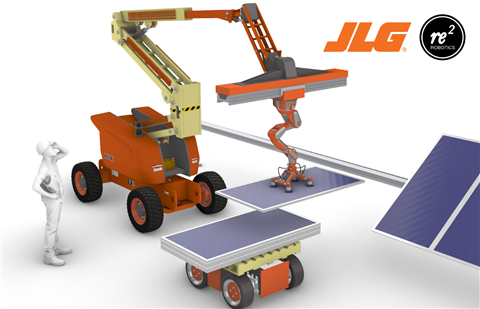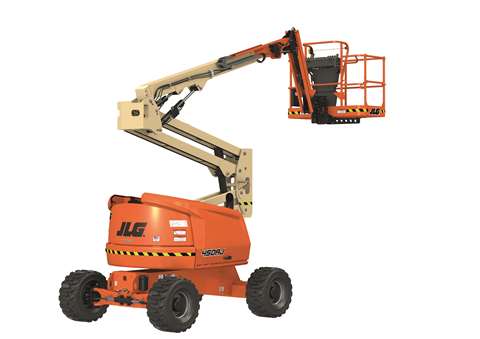Robotics in aerial lifts
28 February 2022
AI Speaks with JLG’s Rob Messina about the company’s development of a remote-controlled robotic lift that will help open the gates to aerial lifts of the future.
Robotic lifts, ultimately leading to completely autonomous aerial units, are becoming a reality and it is one that could help to solve the serious challenges we are experiencing today, for example, labour shortages.
JLG Industries has announced a partnership with a US-based robotics specialist to initially produce a remote-controlled aerial lift, with no basket, to install solar panels.
The project with RE2 Robotics represents the first real steps towards autonomous aerial lifts, and in this case helps solve the problem associated with finding skilled labour at a remote location, along with offering many safety and productivity advantages. Looking ahead robotic lifts are destined to address the same range of challenges found on busy construction sites
Product integration
 Rob Messina, senior vice president of global development and product management, JLGs Industries.
Rob Messina, senior vice president of global development and product management, JLGs Industries.
As Rob Messina, JLG’s senior vice president of global development and product management, explains to Access International, the partnership came about after RE2 was awarded a project by the US Department of Energy to develop a robotic solar field construction system to manipulate solar photovoltaic panels.
The result is the integration of the RE2 Sapien 6M robotic arm, along with its RE2 Detect and RE2 Intellect software, with a JLG aerial platform. Once completed, the unit will transfer, lift and place the photovoltaic modules.
Solar panel placement is an ideal first application for this type of equipment, says Messina, “As companies look towards sustainability, primarily with carbon footprint reduction, there’s a lot of interest in providing power that comes from non-fossil fuel sources.
“One of those sources is solar and solar fields. And, as solar fields go into typically austere locations, we can often see shortages of labour. So, there’s been an interest from many start-up [companies] to automate specific tasks that are required on the end-to-end build-maintain-refurbish cycle of a solar field. ‘How do we look at the ecosystem of a solar field and automate dull, dirty, or dangerous work with robotics’?”
JLG has been exploring the potential of robotics for some time, starting with a concept telehandler-based unit in 2010. And, as an active member of Pittsburgh’s Carnegie Foundry, set up to drive forward advances in artificial intelligence and robotics, Oshkosh, with JLG, have a commitment to take that a step further.
As a result, when JLG saw RE2 had a specific need for a robot-based lift, the company offered its expertise. “We’ve been involved in autonomy for a long time,” says Messina, “And we saw a robotics company interested in a project, where the aerial work, I would say represent half of the solution. So, the idea came together to integrate the robot with the work platform for that piece of the solar field installation.”
Tech partnerships
JLG has been producing aerial lifts for more than 50 years, however, as technologies emerge in different fields, forming partnerships with specialized technology companies makes sense. For example, says Messina, “With RE2 being a leader in the robotics space, we started talking.”
 A graphic of the JLG and RE2 integrated unit.
A graphic of the JLG and RE2 integrated unit.
Solar panels on large scale solar fields are very heavy and need to be installed onto a fixed frame, and it is the specific task of manipulating the panel at height and putting it in place that JLG and RE2 are working on.
In this case, the movements of the robotic arm attached to the base unit will be controlled autonomously. So far, the integration of the robotic arm and MEWP has taken place and an initial unit has been assembled. The software has also been designed and now the machine has entered a relatively long-term refinement phase.
As Messina adds, the basic mechanical integration of the robotic arm to the core machine is relatively straightforward. “We used a mature robot and a mature AWP, so the exercise is more about ‘how do you control this machine? - It’s more of a controls and software exercise at this phase of the project.”
This refinement stage is crucial and will take a bulk of the total development time to complete satisfactorily. Messina continues, “The core is straightforward. What we will spend all of our development time on over the next year is working through what are called edge cases.
“There’s quite a bit of work around functional safety of robots and how you ensure all the interaction points are defined.”
This means that, as with any new product, all parameters must be fully tested to ensure the robotic arm, base unit, control system and software work together smoothy and safely throughout the working envelope.
In summary, the RE2 Sapien intelligent robotic arm provides a high strength-to-weight ratio, precise control and human-like dexterity to place the burden of the heavy lifting on the robotic system and precisely place the panels onto the racking system. Thereby, significantly improving productivity and reducing the amount of time required to construct a solar field.
Autonomous elements
However, while the panel placement is carried out via a robotic arm, a level of autonomy has been designed into the unit, as it will use computer vision to autonomously retrieve the solar panels from a delivery vehicle, then place them onto a racking system. An onsite worker then secures the panel. As such, the system represents a step towards an aerial lift being able to operate autonomously to carry out the complete process.
 The base unit of the robotic lift is the JLG 450AJ.
The base unit of the robotic lift is the JLG 450AJ.
“It is a bridge to autonomy,” says Messina, “which is [currently] aspirational. But we’ve seen over the last five years, a tremendous number of companies try to mature technology in the autonomy space.
And, typically, as a greater number of customers are found for autonomous equipment, economies of scale will bring the cost down. “For large solar fields in remote locations, it was an ideal application to consider developing technology that could assist in the building phase, as well as the maintenance phase.”
And, in the not-too-distant future, that time will come for the construction sector, Messina adds, “these technologies will get closer and closer to being within reach for the construction industry. “We’re at an early stage, although there’s a tremendous amount of interest because if we can be successful here, there’s a clear case for a robot in this application.”
Labour challenge
Indeed, the extensive work with RE2 for the solar project is bringing that future ever nearer, not just in the complex adjustments required to make the lift suited for a robotic application but also by making it a more viable option for potential customers. “This is a great example of co-development and how we morph the machine and the robot to do the job more effectively and at a better price position for the customer.
“This is the same maturity curve that all tech goes on; it starts really expensive and as we define and optimise and add scale, we bring the cost position down, which makes it more affordable to a broader range of customers.”
Indeed, this affordability will make robotic and even autonomous aerial equipment attractive to a construction sector where the cost of labour is a current and very real challenge.
On that topic, Messina comments, “Just reflecting on the pandemic. That triggered a lot of people to make changes; maybe deciding they want to retire earlier. We were already facing a challenge where we had an aging workforce.”
Driving adoption
In response, JLG is looking at all elements of the business, from the manufacturing floor to the job site and everywhere in between. Apart from work towards a robotic solar field machine, the company is implementing semi-autonomous and autonomous operations wherever relevant and possible to plug those gaps that can no longer be filled by a human worker. Although, JLG is keen to point out that it is not aiming to replace its existing human workforce.
In turn, younger generations can be more accepting of how new technologies can enhance a workplace, and that, of course, includes robotic and potentially autonomous MEWPs. Messina concludes, “I think what may help us drive adoption, is now we have folks coming into the workplace that are very familiar with gaming interfaces, very familiar with AR and VR applications and they’re significantly more comfortable with technology.” AI
STAY CONNECTED



Receive the information you need when you need it through our world-leading magazines, newsletters and daily briefings.
CONNECT WITH THE TEAM








